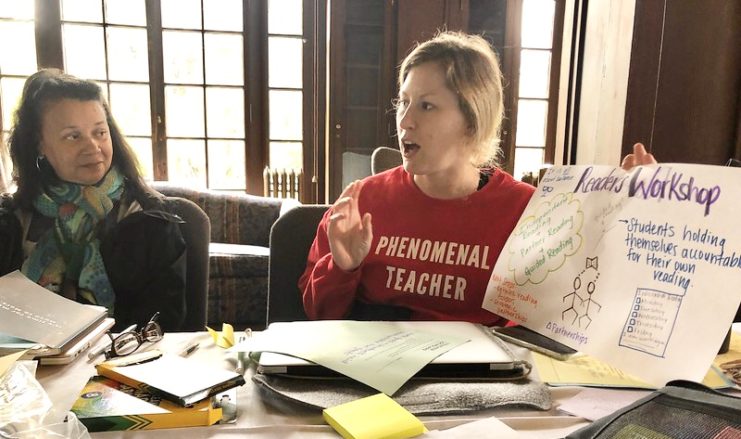
Practicing Public Learning
To create an adult learning culture in the service of every student, the process of learning must be visible and valued across all levels of the organization.
Why practice public learning?
So often, in an effort to support school improvement, we instinctively highlight and display an educator’s most successful instructional practices as a model. But if the aim is to build a learning culture for adults, then the teachers’ learning process needs to be highlighted. Sharing uncertainties about the work, gaps in knowledge, and nuggets of discovery within a community is vital to establishing a learning culture.
One of the most powerful ways to shift the adult learning culture in schools and districts is through public learning. By making learning public by design, we acknowledge the uncertainty and complexity inherent in the work of teaching. When teachers go public with the questions they have about their students’ learning and then share the data they collect to help answer those questions, learning becomes the centerpiece of powerful teaching.
Public learning is not, however, a one-way street. It depends on a dialogue between the public learner and their colleagues. This dialogue requires social and emotional support—both to be vulnerable and share uncertainty, and to be open to supportive challenge from colleagues. Inviting multiple perspectives on the public learner’s student data and thinking is also an equity strategy, as everyone shares the responsibility for supporting all students.
Public learning
- Encourages a culture of questioning assumptions and biases
- Supports the vulnerability required for educators to question what is or isn’t working in their own practice
- Encourages teachers to build their own knowledge about student learning
- Builds an asset-based stance towards students and adults
Stepping into the practice
One of the best ways to begin practicing public learning is to provide teachers a model of what it looks like. Preparation and gathering data ahead of the exercise are key.
Invite one educator to model public learning in front of the group.
This “fishbowl-style” conversation provides a common experience for the group to think about public learning together. It also helps build trust and community.
Several steps help make the process a success:
-
In advance of your meeting, invite one teacher to be the public learner and share a student learning dilemma. Consider choosing someone who is reflective and open to sharing uncertainties.
-
To help prepare your public learner:
-
Ask them to collect relevant student data from two or three focal students.
-
Ask them how they feel about sharing in front of the group. Is there anything that worries them about discussing their uncertainty and data with colleagues?
-
-
Open the session by framing the purpose of public learning not as searching for the right answer, but figuring out how to best serve your students, and honoring the value of that complex process.
-
Invite the public learner to share their student learning dilemma and the data related to it. Ask them to think aloud about what the data reveals about their students’ understanding.
-
Take on the role of the listener in the conversation and ask the “public learner” questions that support their learning.
-
What is your learning goal for students?
-
What would success look like if students were meeting this goal?
-
What do you notice in your data?
-
What does your data tell you about your students’ progress towards your goal?
-
-
Ask the group to discuss what they notice about the data.
-
Return to the public learner and ask them what they’re thinking at the end of the conversation.
-
Express gratitude to the public learner and acknowledge that it isn’t easy to share uncertainty in front of colleagues.
-
Invite all teachers to think about the public learning experience.
-
What was it like to be the public learner?
-
What was it like to be in the role of the listener?
-
How did the public learner’s thinking change during the conversation?
-
-
Provide time for teachers to work in pairs or trios, giving everyone a chance to be the public learner.
We suggest you try this partnership approach first: “Go public” with your own learning.
Going first and trying public learning out yourself signals to teachers that you’re learning alongside them, and allows you to build empathy as you experience first hand what you want teachers to experience. To demonstrate the process:
- Be honest with teachers about a professional dilemma.
- Model taking a learning stance by wondering aloud about your uncertainties related to the dilemma.
- Discuss what information might better help you understand what’s happening for your learners.
- Model looking closely at that information to see what it reveals about learning.
- Invite teachers to share their perspectives on your thinking and data. Encourage them to ask you clarifying and/or probing questions to help you move forward.
